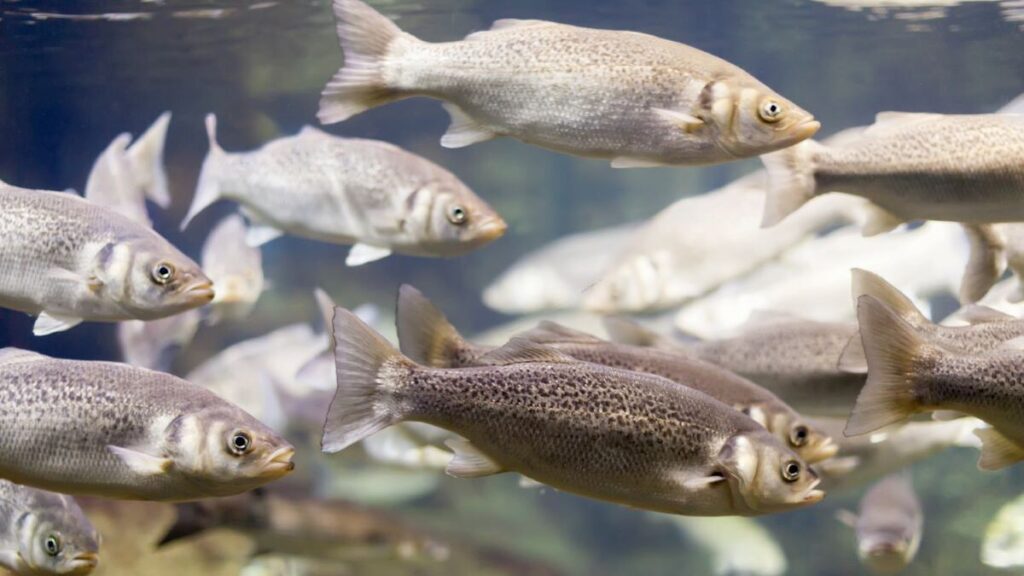Introduction
Trout farming has been integral to the USA’s aquaculture industry for decades, providing high-quality fish for commercial and recreational purposes. With its rich natural water resources, the USA has established itself as one of the leading producers of farmed trout, contributing significantly to the economy and employment sector. However, as we step into 2025, a formidable challenge threatens the future of this industry—climate change.
- Introduction
- The Current State of Trout Farming in the USA
- How Climate Change Affects Trout Farming
- Can Trout Farming Survive Climate Change?
- The Role of Government and Policy in Protecting Trout Farming
- Sustainable Practices for Future-Proofing Trout Farming
- Innovations and Future Trends in Trout Farming
- Economic Impacts and Market Trends for 2025
- Challenges and Potential Solutions
- Conclusion
Rising global temperatures, unpredictable weather patterns, and deteriorating water conditions pose serious risks to trout farming operations. Trout, being cold-water fish, thrive in environments with stable, oxygen-rich water. However, with climate change altering these conditions, the industry faces a tough road ahead. Will trout farming withstand the test of climate change, or is it a death sentence for the industry? Let’s dive deeper into the challenges and potential solutions.
The Current State of Trout Farming in the USA
Major Trout Farming Hubs and Production Statistics
The USA boasts several key regions specializing in trout farming, including Idaho, North Carolina, and Pennsylvania. Idaho alone accounts for nearly 70% of the nation’s farmed trout production, thanks to its ideal water conditions. The industry provides millions of pounds of trout annually, catering to domestic consumption and international exports.
Economic Significance and Employment Opportunities
Beyond supplying fresh trout to markets, trout farming supports thousands of jobs nationwide. The industry is crucial in rural economies, from hatchery workers to processing plant employees. Moreover, trout farms generate revenue through recreational fishing programs, attracting anglers and boosting local tourism.
Common Challenges Faced by Trout Farmers
Despite its success, the trout farming industry is not without its struggles. Farmers grapple with fluctuating feed costs, water use restrictions, and increasing competition from alternative fish species. Moreover, disease outbreaks, often exacerbated by rising water temperatures, pose a significant threat to trout populations. These challenges are only expected to intensify as climate change progresses.
How Climate Change Affects Trout Farming
Rising Water Temperatures and Their Impact on Trout
One of the most immediate effects of climate change on trout farming is the increase in water temperatures. Trout thrive in cool water, typically between 50-60°F. However, studies indicate that many freshwater sources in the USA are warming, pushing temperatures beyond trout-friendly thresholds. This change leads to slower growth rates, higher stress levels, and even mass mortality in severe cases.
Altered Water Quality and Oxygen Levels
Warmer water holds less dissolved oxygen, a critical factor for trout survival. Reduced oxygen levels can lead to sluggish behavior, increased susceptibility to diseases, and, in extreme cases, suffocation. Additionally, changes in rainfall patterns and drought conditions can alter water flow, leading to stagnation and degrading water quality.
Increased Disease Prevalence in Farmed Trout
Higher temperatures create a breeding ground for pathogens and parasites. Bacterial gill disease and furunculosis have become more prevalent in trout farming operations. Without proper disease management strategies, entire fish stocks can be wiped out, causing devastating financial losses for farmers.
Can Trout Farming Survive Climate Change?
Despite the grim outlook, trout farming can still adapt to the changing climate with the right strategies. Farmers, scientists, and policymakers work together to implement innovative solutions to sustain the industry.
Adaptation Strategies for Trout Farmers
Some farms have begun shifting operations to higher-altitude locations where water remains cooler. Others invest in deep-water wells to maintain optimal conditions for their trout populations.
Technological Innovations in Trout Farming
Advanced monitoring systems allow farmers to track real time water temperature, oxygen levels, and disease outbreaks. Automated aeration systems help maintain stable water conditions, reducing the impact of climate fluctuations.
Sustainable Water Management Techniques
Conserving water resources is another key approach. Many farms are adopting recirculating aquaculture systems (RAS), which filter and reuse water, minimizing waste and reducing dependency on external water sources.
The Role of Government and Policy in Protecting Trout Farming
Federal and State Regulations Supporting Sustainable Aquaculture
Government agencies have introduced policies to promote sustainability to mitigate climate change’s effects on trout farming. The U.S. Department of Agriculture (USDA) and the National Oceanic and Atmospheric Administration (NOAA) regulate and support the aquaculture industry through grants, research programs, and sustainability initiatives. State-level agencies enforce water conservation rules and regulate aquaculture practices to ensure environmental stability.
Climate Policies Affecting Fisheries and Trout Farming
With the increasing urgency of climate change, the U.S. government has implemented policies focused on reducing carbon emissions and protecting aquatic ecosystems. Some of these policies include restrictions on industrial pollution, incentives for clean energy use in aquaculture, and funding for research on climate-resistant fish species. Trout farmers must comply with these regulations while adapting to the changing environmental landscape.
Funding and Research Support for Trout Farmers
Federal grants and private funding opportunities are available to help trout farming operations transition to sustainable models. Universities and research institutions work closely with fish farmers to develop resilient trout breeds, improve disease management strategies, and create more energy-efficient aquaculture systems. These collaborative efforts will be vital in ensuring the industry’s long-term survival.
Sustainable Practices for Future-Proofing Trout Farming
Adoption of Recirculating Aquaculture Systems (RAS)
One of the most promising advancements in trout farming is recirculating aquaculture systems (RAS). These systems filter and recycle water, reducing the dependency on natural water sources. RAS conserves water and helps maintain optimal conditions for trout, making them more resistant to environmental fluctuations.
Selective Breeding for Climate-Resistant Trout Strains
Scientists are developing trout breeds that tolerate higher temperatures and lower oxygen levels. By selectively breeding trout with genetic resilience, farmers can create stocks that are more adaptable to changing water conditions. This technique ensures consistent yields even as climate change intensifies.
Eco-Friendly Feeding Practices
Sustainable feed options, such as plant-based proteins and insect meal, are gaining popularity as alternatives to traditional fishmeal. These eco-friendly feeds reduce the environmental footprint of trout farming while maintaining the nutritional quality of farmed fish. Some farms also experimented with integrated aquaponic systems, where fish waste fertilizes plants, creating a closed-loop system.
Innovations and Future Trends in Trout Farming
AI and Automation in Trout Farming
Artificial intelligence (AI) revolutionizes trout farming by providing real-time data analysis and predictive insights. AI-powered monitoring systems can track water quality, fish health, and feeding patterns, helping farmers optimize their operations. Automated feeders ensure precise feeding, reducing waste and enhancing fish growth rates.
Integration of Renewable Energy in Fish Farms
Many trout farming operations are turning to renewable energy sources such as solar and wind power to reduce carbon emissions. Solar-powered aerators and water pumps help maintain sustainable farming conditions while lowering operational costs. This shift benefits the environment and makes trout farming more economically viable in the long run.
Genetic Advancements for Disease-Resistant Trout
Researchers are exploring genetic modifications and selective breeding to produce trout with enhanced resistance to common diseases. Farmers can reduce their reliance on antibiotics and chemicals by improving disease resistance promoting healthier and more sustainable aquaculture practices.
Economic Impacts and Market Trends for 2025
The Role of Consumer Demand in Shaping the Industry
Consumer awareness of sustainable seafood is driving changes in the trout farming industry. More people demand eco-friendly, responsibly farmed fish, pushing farmers to adopt ethical practices. Supermarkets and restaurants are also prioritizing suppliers that meet sustainability certifications.
Pricing Fluctuations Due to Environmental Stressors
As climate change affects trout farming, production costs are likely to increase. Water management, disease prevention, and energy expenses could increase farmed trout’s price. However, technological advancements and government support may help stabilize prices by improving efficiency.
The Potential Rise of Alternative Fish Farming Methods
In response to climate challenges, alternative fish farming methods, such as offshore aquaculture and indoor fish farms, are gaining traction. These methods provide controlled environments, protecting fish from temperature fluctuations and external pollutants. The rise of alternative farming could reshape the traditional trout farming industry.
Challenges and Potential Solutions
Balancing Profitability with Sustainability
One of the biggest challenges in trout farming is finding the balance between profitability and sustainability. While eco-friendly practices require upfront investments, they often lead to long-term savings and increased market appeal. Farmers must adopt thoughtful financial planning to integrate sustainable methods without compromising profitability.
The Threat of Invasive Species and Ecosystem Disruptions
Climate change is causing shifts in aquatic ecosystems, leading to the spread of invasive species. These species compete with farmed trout for resources and may introduce new diseases. Strict biosecurity measures and habitat management strategies can help mitigate these risks.
Public Awareness and Education on Sustainable Trout Farming
Educating consumers, policymakers, and aspiring farmers about the importance of sustainable trout farming is essential for the industry’s future. Outreach programs, certifications, and transparency in farming practices will strengthen public trust and encourage responsible fish consumption.
Conclusion
The future of trout farming in the USA is undoubtedly challenging, but it is not doomed. Climate change alters water conditions, increases temperatures, and intensifies disease risks, making traditional farming methods less effective. However, farmers are not standing still. They are adopting recirculating aquaculture systems (RAS), using AI-driven monitoring, and selectively breeding trout for resilience. Government support through funding, research, and policy reforms further strengthens the industry’s adaptability.
As 2025 approaches, the industry’s success will depend on collaboration among farmers, scientists, policymakers, and consumers. Sustainable practices, innovative technologies, and responsible water management will ensure that trout farming remains profitable and eco-friendly. By embracing change and prioritizing sustainability, the USA can continue to lead aquaculture, providing a stable, resilient future for trout farming despite environmental uncertainties.


